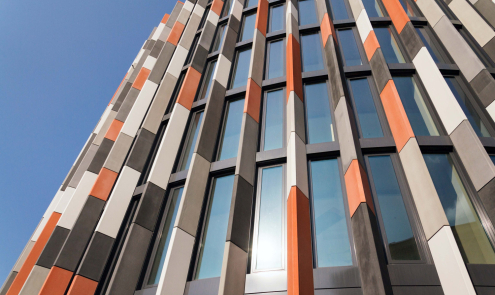REDUCING WATER NETWORK DEMAND: WHY BUILDING DESIGN MAY HOLD THE KEY
09 Jun 2025
While the UK government is understandably focused on carbon emissions, especially with the 2050 net zero target rapidly approaching, water could well be the next scarcity in the coming years.
With the UK’s population steadily increasing, the need for new housing developments also increases, leading to more households and individuals requiring water and further pressure on the water network.
Additionally, with property owners becoming increasingly technology-conscious, more UK buildings feature larger and more water-intensive appliances, such as dishwashers and washing machines.
The important role building design can play in reducing water consumption
While much of the conversation has centred around behavioural change and infrastructure upgrades, building design may play an essential role in reducing water demand before it’s too late.
In fact, buildings aren’t just passive consumers of water – they are also a crucial aspect of how water is used, stored, and reused. Everything from the design of green roofs, the choice of fixtures, and the placement of pipes can affect how much water is drawn from the municipal supply.
This is supported by a 2023 study by the International Water Association – which found that water-efficient buildings could reduce demand on local networks by up to 40%. With that in mind, it’s important to understand just how building design can reduce water demand.
Efficient plumbing layouts
Many UK properties still utilise traditional plumbing systems – which can often result in long wait times for hot water. Consequently, this leads to water wastage. The design and implementation of more efficient pipe layouts, or the incorporation of on-demand hot water recirculation systems, can reduce this waste significantly.
Utilising water-efficient systems
Advancements in technology have seen huge improvements in water efficiency, especially through the use of low-flow toilets, taps, and washing machines. Alongside the specification and installation of these innovative systems, architects and building designers can also design buildings that recycle greywater from sinks and showers for irrigation or toilet flushing.
Smart controls and real-time monitoring
The application and use of data is rapidly becoming crucial in the monitoring, management, and control of water and energy efficiency. By designing and building smarter buildings that feature integrated water monitoring systems, architects and designers can enable building owners, facility managers, and occupants to detect leaks, adjust usage patterns, and optimise water flow in real-time.
Water-sensitive urban design
The principle of ‘water-sensitive urban design’ is gaining importance across the world, including the UK – especially with the significant population growth Great Britain is seeing. This innovative approach integrates the urban water cycle – including groundwater, wastewater, and stormwater – into building design and urban planning.
In fact, this principle is now embedded into building regulations in Sydney, Australia, while water recycling systems are part of new developments in Singapore.
Water calculations
Sustainability consultants, such as Whitecode Consulting, offer specialist water calculation solutions to help building owners and facility managers comply with Part G of the building regulations. Undertaken during the design process, these calculations will identify the potential consumption of water per person per day – important given dwellings are required to have a maximum consumption of 125 litres per person per day. Of course, in major urban conurbations – such as London – targets can often be less than this, with England’s capital seeing a benchmark of 105 litres per person per day.
The importance of regulatory support
While the importance of building designers and architects implementing water efficient systems, layouts, and technologies into the design of residential and commercial buildings across the UK is increasing all the time, the government and policy makers have a vital role to play.
By updating building regulations, investing in better education, and offering building designers and owners financial incentives, key decision makers can encourage or even mandate water efficient designs.
Reducing water network demand isn’t just about conserving a precious resource; it’s also about futureproofing buildings and cities. Utilising smarter layouts, sustainable features, and integrated water systems, building design offers a substantial lever for change and one that can help secure water for generations to come.
Due to population growth and climate change, water demand is causing significant challenges for the network. This is especially the case in South East England where water shortages may be likely due to demand exceeding supply. Ellen Huelin, Sustainability Director at Whitecode Consulting, looks at the causes of the increased water network demand and reveals how effective building design can, alongside consumer water conservation, provide a solution.

The fight for facades: Why M&E must shape...
With sustainability and energy efficiency, not to mention decarbonisation, increasingly taking priority during building design, MEP engineers and architects are coming into conflict as part of an ever-changing air quality...
Read MoreLike to Know More? Let's Talk...








